When I did my previous post on Mort Meskin, I somehow missed an excellant biography on Mort. It is located at a web site called Top Two Three Films. Seems like a strange place for an article about a comic book artist. But it is the best write up on Meskin that I have read and is worth a visit.
Category Archives: 2006/06
Joe Albistur, another forgotten comic book artist
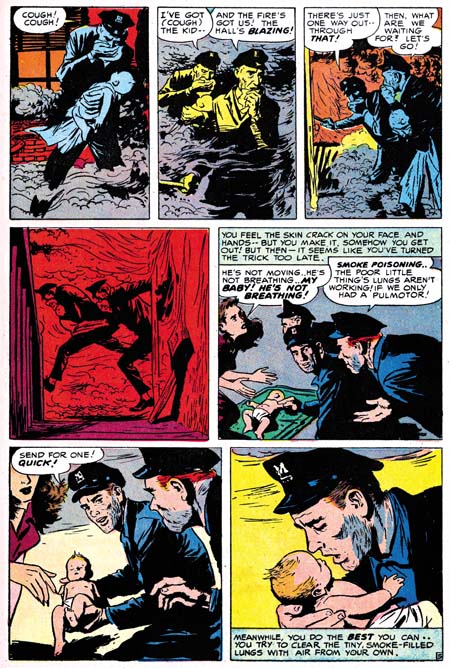
Police Trap #1 (September 1954) “The Beefer” by Joe Albistur
I mentioned Joe Albistur briefly in Chapter 3 of my “End of Simon and Kirby” serial post. Joe is another of those forgotten comic book artists. Web searches have provided nothing in the way of real biographical information. To make matters worse, some have misread his signature and refer to him as Al Bistur. It is easy for me to resist the temptation to look down my nose at those who got his name wrong. Honest mistakes made in the study of comic book history deserve correction not criticism. Besides I have to include myself among those who have made that particular mistake.
I asked Joe Simon about Albistur. Although Simon said he felt he should remember the name, and even corrected my pronunciation, he could remember nothing about him. In a way this is not surprising. Simon worked with a lot of artists over the years and Albistur worked for the S&K studio for only a short period of time. But it was that critical time during the Mainline period. Albistur first appeared in Police Trap #1 (September 1954) and last showed in Young Romance (October 1955). During his stay with S&K Joe produced 21 stories; 6 for Police Trap, 1 for Win A Prize and 14 for the Prize romance titles (see checklist). His appearance in these particular comics, but none of the other Prize titles, is one of the reasons I am convinced that Simon and Kirby were still producing the Prize romance titles at the same time they were publishing their own comics under Mainline.
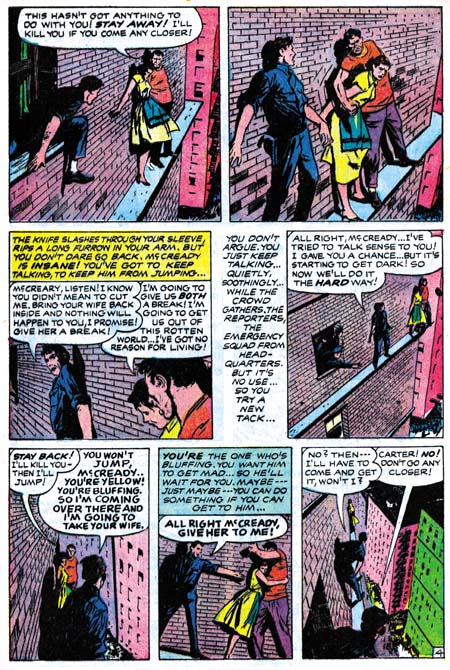
Police Trap #4 (March 1955) “All In A Day’s Work” by Joe Albistur
Joe Albistur shows up in S&K productions with a fully developed style, he must have worked in comics elsewhere before this. Joe does a good job in the mild type of crime genre that is supplied by Police Trap. Albistur illustrates the story well and seems comfortable with the action sequences. He excels in presenting a story in unusual situations; on the ledge of a building where a cop tries to talk someone out of suicide, or in burning building rescuing a baby. Kirby is said to have provided layouts for S&K freelancers, but the way Albistur does these stories I doubt it is true in his case.
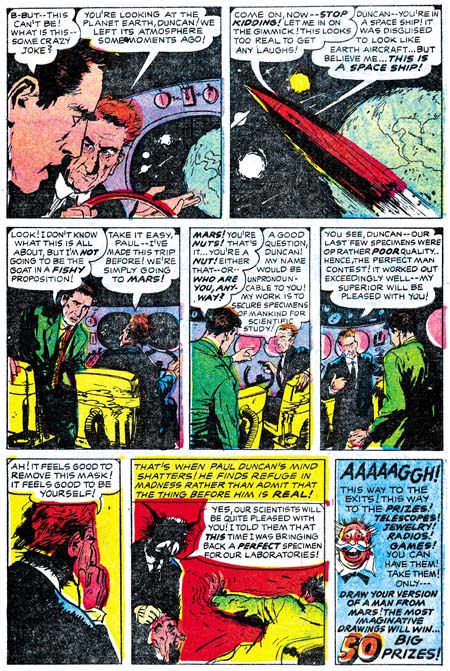
Win A Prize #2 (April 1955) “The Handsome Brute” by Joe Albistur
In Win A Prize #2 Joe’s contribution is a science fiction piece. Here again Albistur shows his story telling ability. But it also shows his weakness. When it comes to the part the alien reveals himself, Joe does not seem to know how to visualize him and so casts the face in shadow. Somewhat of a letdown. Of course it may have been difficult working for Jack Kirby, who is a master at this sort of thing. Black Magic had already been cancelled and Win A Prize never went past the second issue, so we never get a chance to see Albistur try his hand at this sort of thing again.
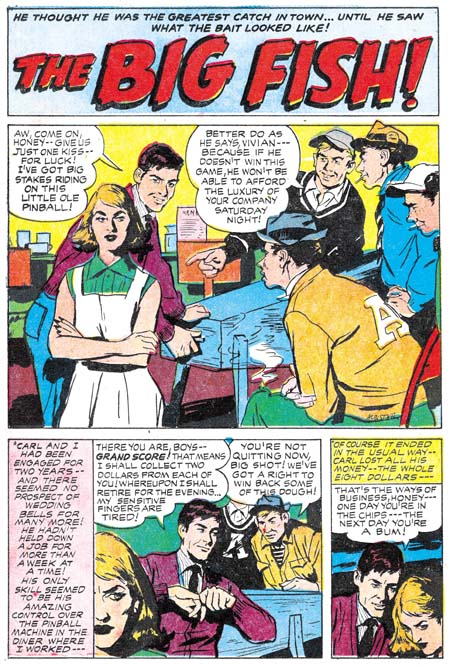
Young Romance #77 (June 1955) “The Big Fish” by Joe Albistur
It was in the romance genre that Joe Albistur did most of his work for S&K, filling in for the absent Jack Kirby. Albistur seems an odd match for the romance comics. His women do not have the clear beauty of Bill Draut, nor the sophistication of John Prentice, nor are they stylized like Mort Meskin’s. I am lost for words on how to describe Joe’s women. The best I can do is say that they have a sort of roughness that gives them an earthy look. But we do not need to accept the quality standards of a teenage girl from the 50’s. I am not sure they would have liked Joe Albistur’s work that much, but I do. Joe used some interesting composition devices, like having a panel edge cut off much of the face of the leading woman. Albistur also had an eye for gestures, like the pin ball wizard stretching his fingers. Although Joe’s women may not have a typical comic book beauty, they are done in an easily recognized style. I have little interest in a style for style sake. But I do admire an artist who develops a unique style as a way of expressing his own personal voice. That is a quality that Joe Albistur shared with the best of the S&K artists.
When Jack Kirby returned to providing work for the Prize romances he would begin to do pretty much the entire comic. Therefore Joe Albistur disappears from the Prize romance titles. Unlike Bill Draut and John Prentice, he does not show up in the Harvey romances. I suspect his work was not a good match for the Harvey house style of those romances. I have not seen any of Albistur’s post S&K work, but he does come up a few times in a search of the internet. It appears he did work for Gilberton in 1961 working in the Classics Illustrated and the World Around Us titles. In 1973 and 1974 Joe shows up in the DC titles Forbidden Tales of Dark Mansion and the House of Secrets.
Joe Albistur was not as flashy as some of the more popular artists, you know someone like Jack Kirby. But at least in the work he did for S&K, he was not a run of the mill artist either. Albistur had talent and his own unique voice. He may not have been a superstar but he does not deserve the anonymity that he has fallen into.
The End of Simon & Kirby, Epilog
Originally I was going to provide a summary of the events from the end of the Simon and Kirby collaboration. Instead I think it maybe more helpful to provide a time line (see below). But I do want to say something about the end of the partnership. Unlike my discussions in previous chapters, here I will be using calendar, not cover, dates. For me the final years of the Simon and Kirby team unfolded in a three stage process. The first was the end of the studio, probably sometime in 1955 between February (last release of Mainline comics ) and August (when Kirby returned to working in the Prize romance titles). After this the two continued to collaborate on projects, but the way they worked was not the same. The next stage was when Jack began to do freelance work around April 1956. With that, Simon and Kirby projects became just one of Jack’s commitments. Finally came the canceling of Alarming Tales and Race For The Moon after October 1958. From this point on Jack would give a hand on Joe’s projects, but they would not really be Simon and Kirby productions.
I would not be surprised if there were some hard feelings between Joe and Jack after the failure of Mainline. After all both had invested a lot of time and money. But if there were any bad sentiments they were not strong enough to prevent the two from working together. For every project that Simon got Harvey to do, Jack always came through with enough material to fill at least the initial issues. Everything leads me to believe that if any of those projects had been successful enough, Joe and Jack would have truly rejoined and opened another studio. But without any hits and with the need to support their families, there really was no way that they could renew the collaboration that they had in the past.
Would the collaboration have lasted if they had never started Mainline? Well Joe says that they invested a lot of their own money into that venture. Had they not lost that investment there would have a more resources to fall back on during this difficult period. But Prize still had its problems. How long could the team have weathered the canceling of titles and the lowering of profits? Although in the end Prize survived, it was a diminished company. The only way the S&K studio could continue would be to find new work. But that is exactly what Joe had tried to do after Mainline’s failure. Why would things have been any different without Mainline? With the shrinking of the comic book market during this period there was less opportunities left for a studio like Simon and Kirby’s. Even without Mainline, I am sure that Joe and Jack would still have had to go their separate ways in the end.
This series of posts was based primarily on the comics themselves and my own data base. I will list what few references I used after the Time Line. Among them is the paper by Thomas Lammer, which provided the dating for the Atlas Implosion. Although Tom’s work appeared in Alter Ego (volume 3, #49), I used his expanded self published version. I cannot think of a finer scholarly work of comic book history. If you don’t have a copy already, I strongly recommend you get one from Tom. He still has copies and are available for $12 (US & Canada) order from tlammers@new.rr.com.
My viewpoint about the events I covered here has been shaped by discussions with others. Unfortunately my memory is not good enough to always remember where credit belongs. But the Kirby List has a number of knowledgeable people and often spirited debates. But I would like to particularly thank the fine scholar Stan Taylor who I believe was the one who pointed out the oddly shaped panels in the initial Challengers. He also helped me clear up my confusion about Young Love caused by duplication in volume numbering. Also of great importance to me have been the email exchanges I have had with Christopher Harder. Christopher is not only one of the finest Simon and Kirby scholars, he shares with me, dare I say, a love of the Simon and Kirby romance comics.
Time Line (Month given within parenthesis is the cover date)
1953 December (February) Young Brides #13 (Prize, last photo cover for Prize)
1954 January (March) Young Romance #67 (Prize, Kirby work stops appearing in Prize romances)
February (April) Fighting American #1 (Prize)
April (June) Senate committee questions Bill Gaines (5/22 & 5/23)
May (July) Young Bride #17 (Prize, last monthly)
June (August) Bullseye #1 (first Mainline)
July (September) Young Romance #73 (Prize, S&K production credits in Prize stop) Young Love #61 (Prize, S&K production credits in Prize stop) Black Magic #32 (Prize, S&K production credits in Prize stop)
August (October) Frankenstein Comics #33 (Prize, last issue)
September (November) Black Magic #33 (Prize, title stops, will resume in 1957)
October (December) Comic Code Authority created (10/26). Young Romance #80 (Prize, last monthly) Young Love #63 (Prize, last monthly)
December (February) Witches Western Tales #29 (Harvey, with Boys' Ranch reprints) Thrills of Tomorrow #19 (Harvey, with Stuntman reprints) Win A Prize #1 (Charlton)
1955 January (March) Police Trap #4 (Mainline, first with Comic Code stamp)
February (April) Bullseye #5 (last as Mainline) Foxhole #4 (last as Mainline) Young Romance #81 (Prize, first bimonthly) Young Love #64 (Prize, first bimonthly) Witches Western Tales #30 (Harvey, with Boys' Ranch reprints) Win A Prize #2 (Charlton) Fighting American #7 (Prize, last issue) Young Love #64 (Prize, return of S&K production credit)
March (May) In Love #5 (Charlton, first of former Mainline titles to be released by Charlton)
April (June) Charlie Chan #6 (Charlton, formerly by Prize in 1948 and 1949) May (July) I Love You #7 (Charlton, continuing from In Love numbering)
July (September) Police Tray #6 (Charlton, last of former Mainline titles to be released by Charlton)
August (October) Western Tales #31 (Harvey, with new S&K material) Young Romance #79 (Prize, Kirby work returns to Prize romance)
October (December) Young Romance #80 (Prize, start of all-Kirby Prize romances, last S&K production credit) Charlie Chan #9 (Charlton, last issue)
November (January) Hi-School Romance #47 (Harvey, first John Prentice for Harvey romance) Warfront #28 (Harvey, Kirby cover) Black Cat Mystery #57 (Harvey)
December (February) Hi-School Romance #48 (Harvey, start of Bill Draut for Harvey romance)
1956 January (March) Love Problems And Advice #38 (Harvey, start of Kirby covers for Harvey romance) Western Tales #32 (Harvey, Simon cover)
May (July) Western Tales #33 (Harvey, last issue) Warfront #29 (Harvey, Kirby cover)
July (September) Leader News goes bankrupt Prize Comics Western #119 (Prize, last issue) Black Cat Mystic #58 (Harvey)
September (November) Young Brides #30 (Prize, last issue) Battleground #14 (Atlas, first Kirby work for Atlas)
October (December) Young Romance #85 (Prize, last all Kirby) Young Love #73 (Prize, Young Love stops, last all Kirby) Hi-School Romance #58 (Harvey, last Kirby Harvey romance cover) Yellow Claw #2 (Atlas, First Kirby work for Yellow Claw)
December (February) Showcase #6 (DC, start of Kirby for DC, first Challengers of the Unknown)
1957 February (April) All For Love v1 n1 (Prize, new romance title, not produced by S&K) Yellow Claw #4 (Atlas, last issue)
March (May) Love Problems And Advice #45 (Harvey, last Bill Draut and John Prentice for Harvey romance)
July (September) Alarming Tales #1 (Harvey) Black Cat Mystic #59 (Harvey) Black Magic #34 (Prize, restart of title) Personal Love v1 n1 (Prize, new romance title, not produced by S&K)
October (December) Russia launches Sputnik 1 (10/4)
1958 January (March) Race For The Moon #1 (Harvey) Alarming Tales #4 (Harvey, last with Kirby) Black Cat Mystic #62 (Harvey, series stops)
February (April) Justice Traps the Guilty #92 (Prize, last issue)
July (September) Race For the Moon #2 (Harvey)
September (November) Sky Masters syndication starts (9/8) Race For The Moon #3 (Harvey, last issue) Alarming Tales #6 (Harvey, last issue)
1959 February (April) Sky Masters Sunday strip starts (2/8) Young Romance #99 (Prize, last time Simon and Kirby listed as editors) All For Love v3 n2 (Prize, includes story by Kirby)
April (June) Double Life Of Private Strong #1 (Archie) Challengers of the Unknown #8 (DC, last Kirby for DC)
June (August) Adventures of the Fly #1 Double Life of Private Strong #2 (Archie, last issue)
July (September) Personal Love v3 n2 (Prize, last issue, title changes to Going Steady) October (December) Young Romance #103 (Prize, last Kirby in Young Romance) All For Love v3 n4 (Prize, last issue, title changes to Young Love)
November (January) Adventure of the Fly #4 (Archie, last produced by Joe Simon) Going Steady v3 n3 (Prize, first issue, title was Personal Love)
December (February) Young Love #74 (Prize, Young Love restarts uses volume number from All For Love)
1960 February (April) Sky Masters Sunday strip ends (2/14)
April (June) Young Romance #106 (Prize, first Joe Simon alone listed as editor)
June (August) Sick #1 (Crestwood [Prize], produced by Joe Simon)
July (September) Going Steady v4 n1 (Prize, last issue)
1961 February (April) Sky Masters end (2/25)
September (November) Black Magic #50 (Prize, last issue)
1963 February (April) Young Romance #117 (Prize, last time Simon listed as editor)
April (June) Young Romance #124 (Prize, last issue by Prize) Young Love #94 (Prize, last issue by Prize)
Bibliography
Cooke, Jon B. “The Story Behind Skymasters”, The Jack Kirby Collector #15
Lammers, Thomas G., “Tales of the Implosion: A Detailed Look at the 1957 ‘Atlas Implosion’ and its Effects on Comic Books” (revised and expanded from article in Alter Ego vol. 3, no. 49
Simon, Joe and Jim Simon, “The Comic Book Makers”
The End of Simon & Kirby, Chapter 10, A Fly In The Mix
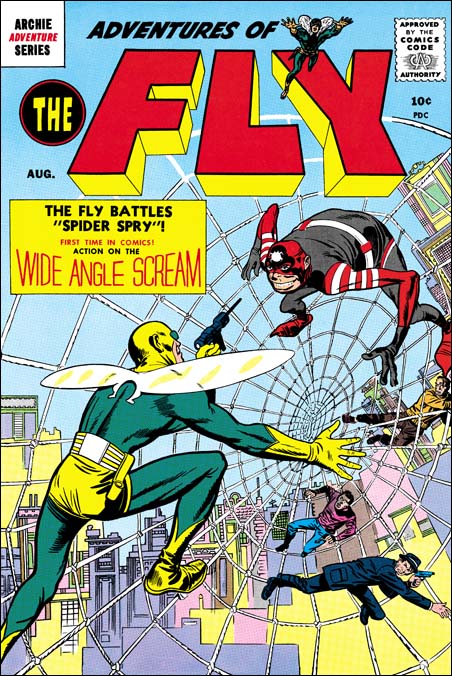
The Adventures of the Fly #1 (August 1959) by Jack Kirby
Previously in the End of Simon and Kirby we saw that after the failure of Mainline and with a decrease in work for Prize, Jack Kirby turned to working as a freelance artist. Joe Simon continued to get Harvey comics to publish various S&K projects but none of them became hits.
After the end of Alarming Tales and Race For The Moon in November 1958, Harvey comics was probably reluctant to try any other new ideas from Joe Simon, at least right away. But that did not stop Joe from coming up with them. As Simon tells the story in The Comic Book Makers, in 1953 C. C. Beck wanted to get back into the comic business and asked Joe to come up with an idea. From this came a character called the Silver Spider and Beck would do a rough drawing of a story that was scripted by Joe’s brother-in-law Jack Oleck. This was presented to Harvey without generating any interest. Years later when Goldwater from Archie Comics wanted a couple of superhero comics, Joe remembered the Silver Spider concept, retrieved the art from Harvey, and rethought the idea. Joe sent Beck’s Silver Spider art to Jack Kirby and ask Jack to update it as the Fly. Joe’s story makes sense to me. Had the Silver Spider originally been a S&K concept, Kirby would certainly have done the original story, not Beck. But it would seem that Jack came up with the costume for the Fly, basing it in part on a unused S&K concept called the Night Stalker.

The Double Life Of Private Strong #1 (June 1959) by Jack Kirby
Joe took this concept of the Fly to Archie Comics and added to it a proposal to re-do an old superhero called the Shield. The original Shield was the first patriotic hero from before when the company was referred to as MJL. The new Shield would be given great powers and would have a secret identity as a soldier, sort of combining the original Shield with Captain America and Superman. Well Archie must have liked Joe’s ideas because The Double Life of Private Strong would come out in June 1959 and the Adventures of the Fly would follow in August. As Joe tells it, a threat of a lawsuit by DC put an end the new improved Shield with issue #2, also released in August.
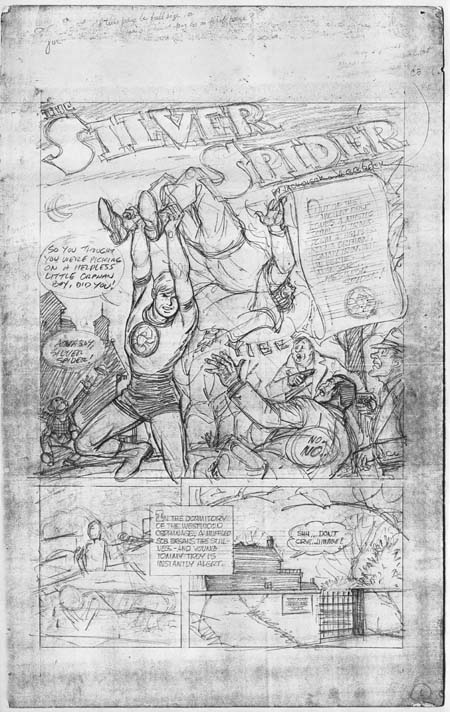
Silver Spider (1953) page 1 by C. C. Beck
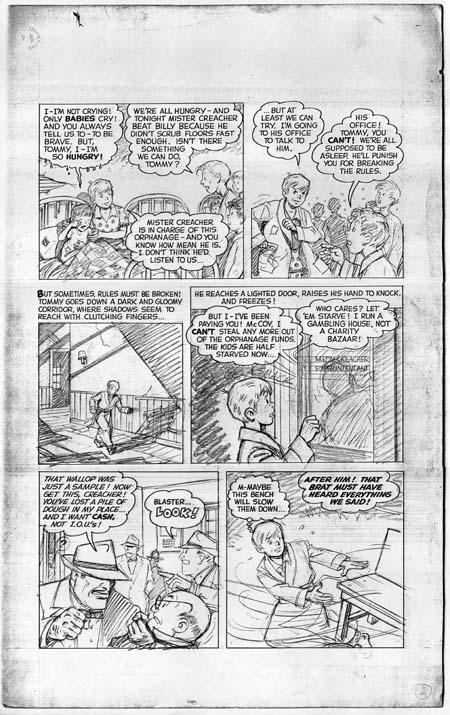
Silver Spider (1953) page 2 by C. C. Beck
The Oleck/Beck story was pretty much retained when Kirby updated it for the Fly. The main difference is that Jack replaced the original genie with an emissary from the Fly People. Kirby did introduce a discrepancy, in both versions the superintendent of the orphans is shown as under threat by mobsters because of a gambling dept. But in Jack’s version he is latter presented receiving his share of the of the orphanage racket and thus acting as one of the gang. This was probably done to streamline the story. Beck’s version required the Fly to first confront the superintendent before proceeding to the gangsters. While Jack made one fight by making the superintendent a gang member.
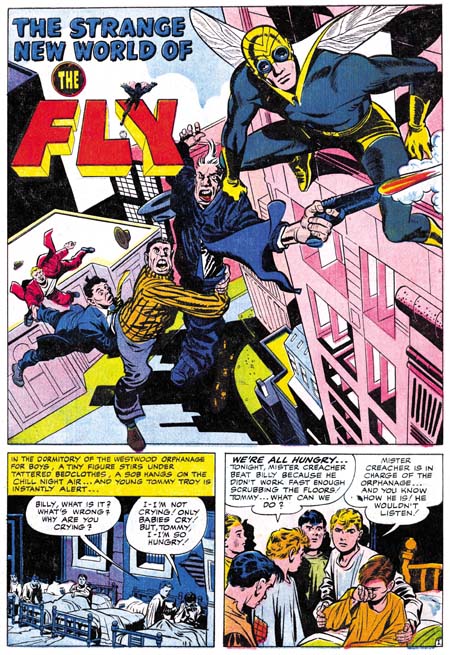
The Adventures of the Fly #1 (August 1959) “The Strange World of the Fly” page 1 by Jack Kirby
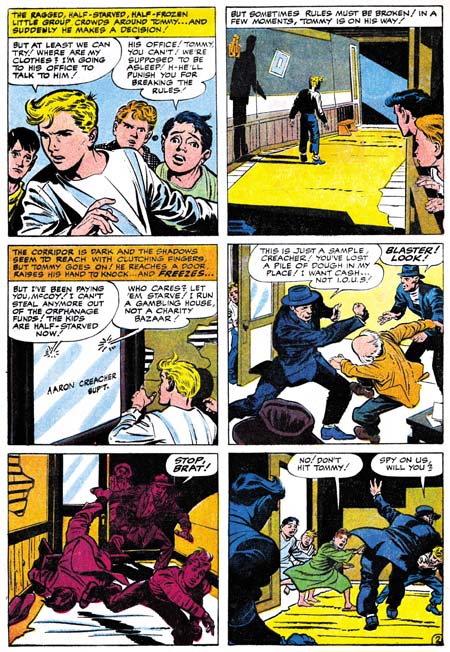
The Adventures of the Fly #1 (August 1959) “The Strange World of the Fly” page 2 by Jack Kirby
Although Kirby came up with the how the Fly should look like, Simon really was the driving force behind this new character. In previous new titles Kirby would generally supply the art, at least for the initial issues. But with the Fly Simon would turn to a number of artists to create the contents; Jack Davis, George Tuska, Al Williamson. He even got Carl Burgos to do layouts. Joe once showed me a list someone made of what artists did what. Unfortunately he followed this by saying that the list maker got it all wrong. Frankly I am not even going to try, with so many hands involved I am not always sure I can always pick out the work that Kirby did. Was Jack too busy with work at Atlas, or did Joe decide he might be better off using different artists? Unlike the Fly, Private Strong did get the Kirby treatment. At least for the first issue, which is all Jack. But the second only has one Kirby story.
Joe still has a lot of the original art and it is interesting as it shows Joe’s working practices at that time. For some of the stories much of the pages are cut and paste jobs. I do not know whether Joe was condensing, rearranging or adding to the story. But a fair portion of these comics went through this special type of editing. Joe would also construct some of the covers in a similar way. He would even swipe Captain America from a 1941 cover (Captain America #7) to make the Fly for the cover to issue #2. As far as I am concerned all the prior projects that came out after Mainline’s failure were Simon and Kirby productions of some kind. But the Fly and the Shields were not, the Simon and Kirby collaboration was over. With the Fly Joe finally seemed to have at least a limited success. But apparently Archie Comics was not completely satisfied and felt it could be better. So after just four issues (January 1960) Simon was out and a new crew took over the Fly.
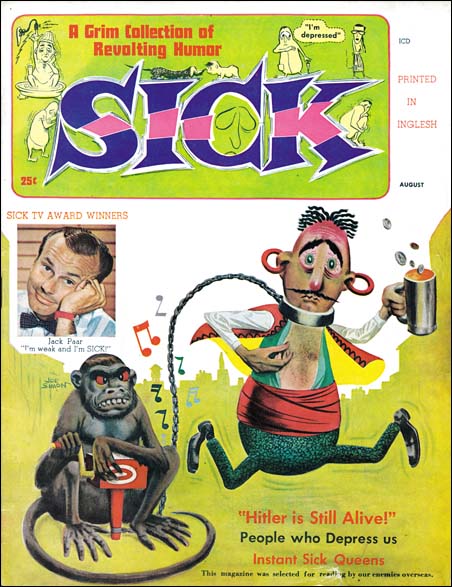
Sick #1 (August 1960) by Joe Simon
On the face of it Teddy Epstein’s new idea just does not sound like a great one. I am amazed that after so many years and so many clones that Prize would want to try publishing yet another copy of Mad. Even more unbelievable is that fact that it succeeded! At lease one reason for that success was Prize turned to Joe Simon to produce it. Joe’s talent for visual humor would now be unleashed in Sick. Of course another reason for the success of Sick was the wonderful artists that Joe would hire. In a way even Jack Kirby showed up when Simon reworked some Fighting American art for a cover (Sick #42 February 1966). Joe would be editor of Sick from until 1968 and would still provide art for it for some time afterwards. During this period Joe Simon would work on other projects, primarily for Harvey Comics. At some point Joe would enter advertisement, but I still do not have a good handle on when that was.
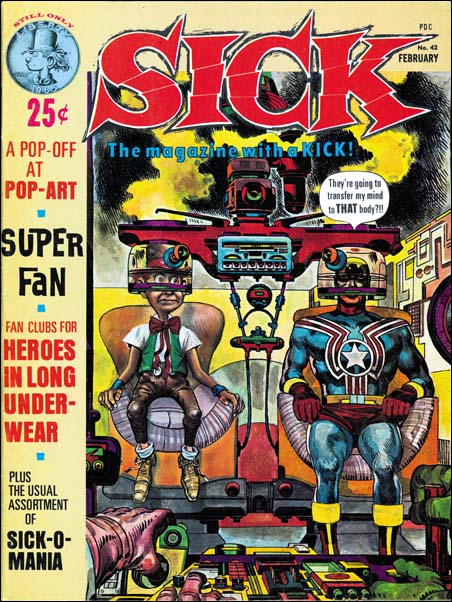
Sick #42 (February 1966) by Jack Kirby altered by Joe Simon
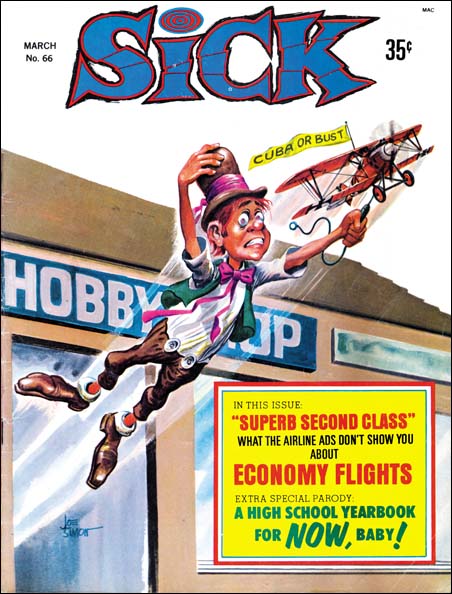
Sick #66 (March 1969) by Joe Simon
Mea Culpa, correction to Chapter 9
In my last chapter to The End Of Simon & Kirby, An Old Romance I said
Prize must have truly started to recover, in August 1957 they relaunched Black Magic. That title had previously been a Simon and Kirby production, but their contract for that title with Prize must have been different. Joe and Jack would never have anything to do with the new Black Magic.
Well on the Kirby List Stan Taylor questioned that statement, pointing out that Dick Ayers has said that he did some work for Joe Simon for Black Magic.
I asked Joe Simon about the relaunced Black Magic and he confirmed that he did them without Jack Kirby. Joe added that they were done on a reduced budget.
So I am correcting my Chapter 9 post to say the following
Prize must have truly started to recover, in August 1957 they relaunched Black Magic. That title had previously been a Simon and Kirby production, but now Joe Simon would produce them on a reduced budget. Jack Kirby would never have anything to do with the new Black Magic.
So my thanks goes to that fine scholar Stan Taylor for this correction.
The End of Simon & Kirby, Chapter 9, An Old Romance
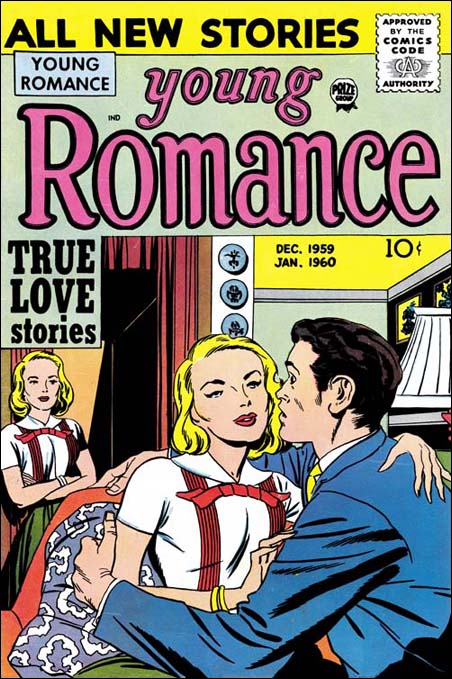
Young Romance #103 (December 1959) by Jack Kirby
Previously in the End of Simon and Kirby their new comic publishing company failed. Joe and Jack produced comics for Prize and shared in the profits. But Prize was also having problems and cancelled some titles. In 1956 Jack would produce all Kirby Prize romance comics. In 1957 we find Jack doing freelance work for DC and Timely. Meanwhile Joe was getting Harvey to publish some new titles however none were big hits.
At the end of 1956 Prize was at a low point. They had one monthly title (Justice Traps The Guilty) and three bimonthly (Young Romance, Young Love, and Young Brides). But they obviously had a plan. In April 1957 Prize would publish a new title All For Love and cancel Young Love and Young Brides. But why cancel two romance titles and at the same time start a new one? For one thing I am sure Prize had not forgotten that three years before they had effectively helped finance Joe and Jack’s Mainline, a competitor comic publishing company. But there could also be a good business reason. Prize had to share the profit on the previous romance titles with S&K, that was part of the deal. If your titles are not making much profit, that left you with even less. But Prize had a contract with Simon and Kirby, I am sure they could not just take a title away. So they did the next best thing, they killed Young Love and Young Brides, set up their own title, and began producing that comic themselves.
As for Young Romance, Simon and Kirby are still listed as the editors in the postal declaration. Whatever their deal was it looks like it was still in place. Prize probably had cold feet about canceling their flagship title, Young Romance. Despite all the freelance work Jack was doing for DC, Atlas and Harvey, he still had time to pencil stories and an occasional cover for Young Romance. Most issues of these late Young Romance would feature one or two stories by Kirby. Jack even did a story of All For Love (volume 3, number 2, August 1959). For whatever reason, few if any, of the former S&K studio freelance artists returned to provide other stories. Despite Kirby’s presence, Young Romance was now just a shadow of its former self.

Young Romance #99 (April 1959) “Man Wanted” by Jack Kirby
The work Jack did for Young Romance after his year of producing the entire Prize romances seems to be a let down. This was the period where Kirby had begun to do freelance work for Atlas (Yellow Claw) and DC (Challengers of the Unknown) so perhaps he just did not devote much attention to Young Romance. Or perhaps it is because these late romances were largely inked by others. Whatever the reason the Young Romance work from 1957 are not the best that Jack has done. But as we enter 1958 the inking begins to change. I would say that by YR #92 (February 1958) a new style has immerged. Faces seem to receive even less spotting then before. Features like the noses, eyes and eyebrows become more abstracted, taking on an almost mechanical look and at times are even distorted. More often then before things like a nostril are indicated only by a thin line. From my description one might get the impression that the inking is unappealing. Quite the contrary, all these abstractions and distortions seemed aimed at an even more expressive effect. Jack’s Young Romance work from 1958 and 1959 is some of the best he has ever done. Jack did the spotting himself, whatever assistance he had with line inking was unobtrusive and the final results are pure Kirby. There are some variations in quality, but not nearly as much as had occurred in the past.

Young Romance #97 (December 1958) by Jack Kirby
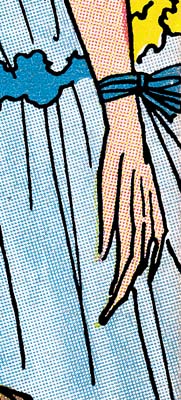
But at least some of the time Jack did seem to get some assistance in inking. It was not unusual for Jack to do a pretty rough job on hands placed near the periphery of the image, particularly women’s hands. Jack would fix up these hands at the inking stage. Most inkers were also artists, so if someone else was doing the line inking they also would correct it. But take a look at the close-up of a hand from the cover to YR #97 (December). What a mess the inker made of it. I am convinced that no artist inker would have done this, only someone who is not an artist would produce such a confused result. In his introduction to the Green Arrow trade back, Mark Evanier says that Roz Kirby helped Jack with the line inking for those stories (July 1958 to February 1959). I am convinced that Roz also helped Jack with at least some of these late Young Romances. I have not made a careful examination of all these YR, but I believe I also detect Roz’s help for the covers to YR #92 and #95 (February and August 1958).
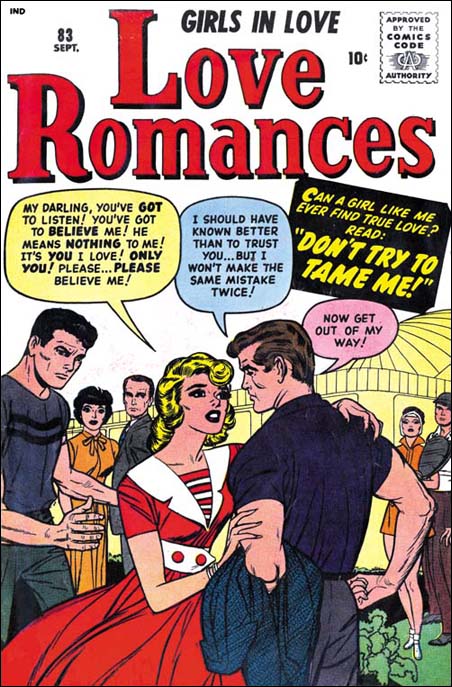
Love Romances #83 (September 1959) by Jack Kirby
While Jack was finishing his tenure as a Young Romance artist, he was beginning to do some romance work for Atlas (soon to be called Marvel). But the work he did for Atlas was inked by other artists. Perhaps even at this early date, Stan Lee was encouraging his inkers to add their personal touches. I am sure he felt this would only improve the end product. But to my eyes there simply is no comparison between the Atlas worked inked by others, and the Prize work inked by Jack himself. But inking is not the only difference, the cover compositions are also different. Since the more recent Prize covers have compositions like those from previous years, it is not the late Prize covers that have changed. More likely Jack at Atlas was receiving instructions on what to do on the covers, perhaps even layouts.
Prize must have truly started to recover, in August 1957 they relaunched Black Magic. That title had previously been a Simon and Kirby production, but now Joe Simon would produce them on a reduced budget. Jack Kirby would never have anything to do with the new Black Magic.
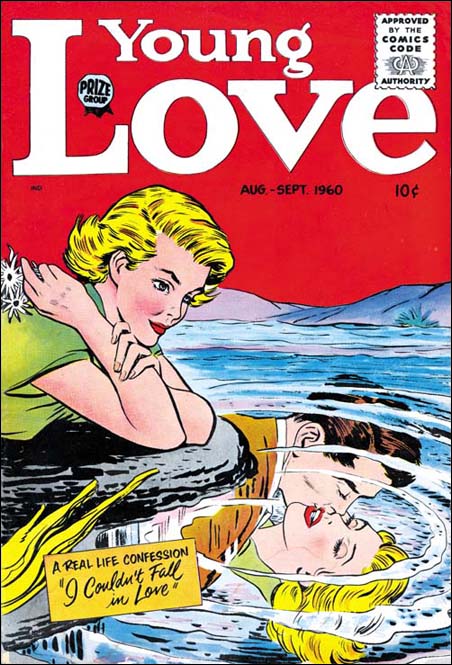
Young Love #77 (August 1960) by Joe Simon
The last Jack Kirby work for Young Romance would be issue #103 (December 1959). Previously the yearly postal declaration statement had listed both Joe Simon and Jack Kirby as the editors for Young Romance. But the next one in June 1960 would only list Joe. January 1960 was the last issue of Prize’s other romance title, All For Love. This cancellation was not a financial decision, instead it was due to the passing away of the editor. Prize turned to Joe Simon to edit a second romance title for them. Apparently Joe preferred to resurrect his old title Young Love, which started right away in February. In order to save on the postal registration fees, Young Love would take up the volume numbering from the All For Love title. Unfortunately the new Young Love would start with volume 3, while the old Young Love had ended with volume 8. This duplication of volume numbers often causes confusion among collectors and dealers. Without Jack Kirby or the S&K freelance artists, Young Romance and Young Love just do not seem the same. But occasionally an interesting artist does show up.
I don’t know how well these late Prize romances were doing, but there must have been some value in the titles because Prize continued to publish them even after canceling Justice Traps the Guilty (April 1958) and Black Magic (November 1961). Joe Simon would remain editor for the two romance titles until the last Prize issues (June 1963). After that Prize Comics would end and DC would take over publishing Young Romance and Young Love. I doubt that Joe continued as editor once DC arrived, but he would return to do some editing on these romance titles years later.

